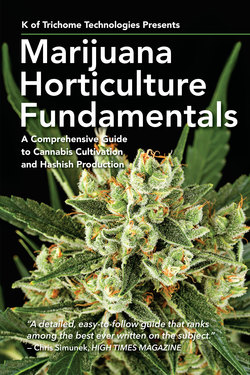Читать книгу Marijuana Horticulture Fundamentals - K of Trichome Technologies - Страница 17
На сайте Литреса книга снята с продажи.
ОглавлениеCHAPTER 1
Cannabis Basics and Gender
Cannabis is an annual plant. Defined as a plant that germinates, grows, reproduces, sows seed, and dies within 12 months, cannabis deposits its seeds to replicate its genetics. The next year’s crop will continue the evolutionary process.
The needs of the cannabis plant are very basic! Light, air, water, nutrients, and soil / medium are the five main needs, and they must be balanced in proper proportions, adjusted to the correct levels, and scheduled to obtain optimum growth rates, results, and overall perfect conditions.
Inadequate attention to any of these details will result in very poor crop yield and quality, if not complete failure. Depending on the methods and techniques you choose, the life cycle of a cannabis plant can be as long or short as you want it to be. To a point, you are in control.
The cultivar (variety / strain) of plant you grow and methodology / techniques you use will dictate exactly how fast or slow your particular garden’s plant life cycle is (e.g., cannabis indica finishes its life cycle much sooner than cannabis sativa). Also, some cultivars root faster than others and some must vegetate longer to produce perfect clone material. In proper conditions, mother plants can be kept indefinitely, ensuring a never-ending supply of clones.
Identifying Male and Female Cannabis Plants
Pollen sacs on a male flower.
A closer look at anthers which will soon open and release their pollen.
Female preflowers.
Young preflowers on a female plant.
Photos: Freebie
Males
Male plants are used for breeding. They must be examined closely to determine whether or not they possess characteristics or traits that are desirable. For sinsemilla production, no males should be present in the flowering chambers—unless you are hoping to get seeds.
Females
Female plants are grown for their flowers, commonly referred to as buds, and the smaller surrounding leaves that have trichomes on them. Buds develop on the top of the plant and tips of the branches and continue downward, beginning at each internode. The bract is round, teardrop-shaped, and has two fuzzy hairs protruding from its tip. These are the stigmas, and their function is to capture pollen and facilitate pollination / fertilization to produce buds. The stigmas are also indicators of successful pollination when breeding and, to a very small degree, of determining pre-ripeness. Buds, obviously, are used for medicine—to be smoked, vaporized, or manufactured into baked goods and hashish.
Hermaphrodites
Hermaphrodites have both male and female characteristics, determined either by genetics or stress. Improper breeding practices can also produce hermaphrodites. Typically, a plant, male or female, will show hermaphroditic traits in later stages of flowering, and can cause pollination. Because of this, they should be separated or eliminated from your other plants. Environmental stress can also produce hermaphrodites—stress from irregular light cycles, light leaks, chemicals, excesses or absences of nutrients and fertilizers, or erratic / extreme temperatures.
Sinsemilla
“Sinsemilla” can literally be translated into “without seeds.” To eliminate the possibilities of pollinating your female plants, there cannot be any males, hermaphrodites, or stray pollen in the flowering chambers. (You would want to include males in the chambers if you’re intentionally pollinating for seed production.) Seedless marijuana is more desirable simply because (from a purchaser’s point of view) a bud that contains seeds weighs more than a bud without seeds, and gives you less bud per gram and thus less smokable product); also, seeded buds require extra preparation and de-seeding / cleaning before being consumed (i.e., smoked, vaporized, etc.). Simply put, seedless buds are better buds. From a market standpoint, seedless marijuana is worth more than seeded marijuana. As of the late seventies / early eighties, all marijuana considered “high grade” is seedless.
Female, Male, and Hermaphrodite Plants
Female preflower with stamen.
This is what the female preflower looks like.
Identify the male by the little sac visible at the internodes.
Macro shot of the preflower visible at the internode.
Closeup of a male plant’s stamen. The anther / pollen sac is visible.
Plants can be forced to produce male flowers / pollen that will produce feminized seeds.
Photos: Jasmin
Female and male flowers are emerging from this hermaphroditic plant.
Young male plant. Identify these early if you don’t want seeded bud.
Maturing female plant with broad fan leaves visible.
That said, it is possible for some cultivars to produce more available THC when seeded because of the increased surface area on the bract. The bracts are made larger by the developing seed. In most cultivars, larger bracts produce more trichomes or at least produce larger trichomes. Again, this only applies to some, not all, cultivars. All of this aside, the fact remains that seedless marijuana is more desirable to the consumer.
This bract is laden with trichomes.
Photo: MoD
This is a mature seeded bud. It is not sinsemilla.
Photo: Mel Frank
A Note on Calyx-to-Leaf Ratio
The female sinsemilla flower is comprised of small, trichome-laden leaves and bracts with stigmata protruding from their tips. The bract is commonly (and mistakenly) referred to as a calyx—hence the phrase “calyx-to-leaf ratio,” a measurement of bracts / calyx to leaves. The bracts are covered with trichomes, more so than the surrounding leaves. In most cases, the higher the bract / leaf ratio is, the higher the THC levels of the bud are. For example, a 60/40 calyx (bract) to leaf ratio is better than a 30/70 ratio and will produce superior buds / flowers both in quality and quantity of overall flavor, strength, and THC levels. Many seed companies use these ratios when they advertise their strains.
